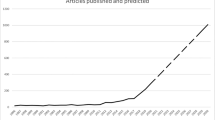Abstract
We believe our readers will concur that one effect of working through these chapters is the realization of the significant number and varying dimensions along which this subject of emerging work and learning skills may be tracked. It is almost simple-minded, but perhaps prudent, to remind ourselves that it could hardly be otherwise. It is a basic exercise, but often awkward, to merely reflect on what a different phenomenon higher education is across the world, after five to six decades of expansion, de-regulation, and massification,1 simply in terms of the numbers of students involved.2 Alternatively, to reflect (if one even has the capacity) on the range, dimensions, and density of technological change that has taken place over the last three to four decades.3
Access this chapter
Tax calculation will be finalised at checkout
Purchases are for personal use only
Preview
Unable to display preview. Download preview PDF.
Similar content being viewed by others
References
Chen, Z. L. 2007. “Implement the Scheme Drawn by the 17th Congress of the CPC, Focus on Upgrading the Quality, and Accelerate the Pace of Turning China’s Higher Education from a Large Scale into a Great Capacity.” China Education Daily, December 12, 2007.
Christensen, C., C. W. Johnson, and M. B. Horn. 2011. Disrupting Class: How Disruptive Innovation Will Change the Way the World Learns, 2nd Edition. New York: McGraw-Hill.
Elrod, S., D. Husic, and J. Kinzie. 2010. “Research and Discovery across the Curriculum,” Association of American Colleges and Universities, Peer Review 12: 4–8.
Hart Research Associates, 2013. “Liberal Education: It Takes More Than a Major: Employer Priorities for College Learning and Student Success.” Available online at: https://www.aacu.org/publications-research/periodicals/it-takes -more-major-employer-priorities-college-learning-and. Accessed: December 31, 2014.
Hendley, J. 2013. “Young, Qualified and Jobless: Plight of Europe’s Best Educated Generation.” The Guardian. Available online at: http://www.theguardian.com/world/2013/jul/01/jobless-europe-young-qualified. Accessed: December 20, 2014.
Hershock, P., J. Hawkins, and M. Mason. (eds.) 2007. Changing Education: Leadership, Innovation and Development in a Globalizing Asia Pacific. Hong Kong: Comparative Education Research Center and Springer.
Hershock, P. 2011. “Information and Innovation in a Global Knowledge Society: Implications for Higher Education.” In The Emergent Knowledge Society and the Future of Higher Education: Asian Perspectives, ed. D. E. Neubauer. London: Routledge.
Hobijn, B. and L. Bengali. 2014. “The Wage Growth Gap for Recent College Grads.” Federal Reserve Bank of San Francisco Economic Letter. July 21, 2014. Available online at: http://www.frbsf.org/economic-research/publications/economic-letter/2014/july/wage-growth-gap-recent-college-graduates/. Accessed: December 20, 2014.
Internet Live Stats. 2014. “Internet Users by Year.” Available online at: http://www.internetlivestats.com/internet-users/. Accessed: December 14, 2014.
Knight, J. (ed.). 2014. International Education Hubs: Student, Talent, Knowledge-Innovation Models. Dordrecht, The Netherlands: Springer.
Neubauer, D. E. 2015. “Talent Competition and Circulation in Asia: What Talents and What Circulation?” In Press.
Neubauer, D. E. and K. Kuroda. 2012. Mobility and Migration in Asian Pacific Higher Education. New York, Palgrave Macmillan.
Neubauer, D. E. and Y. Tanaka. 2011. “Two Decades of Rapid Higher Education Change: Losses and Gains in Equity, Capacity, and Access in Asia-Pacific Higher Education.” In Access, Equity, and Capacity in Asia-Pacific Higher Education, 164–165. New York: Palgrave MacMillan.
Richtel, M. 2012. “Technology Changing How Students Learn, Teachers Say.” New York Times, November 1, 2012. Available online at: http://www.nytimes.com/2012/11/01/education/technology-is-changing-how-students-learn -teachers-say.html?pagewanted=all&_r=0. Accessed: December 23, 2014.
Steger, M. B., P. Battersby, and J. M. Siracusa. 2014. The Sage Handbook of Globalization, Volumes 1 and 2. London: Sage.
Western Association of Schools and Colleges (WASC). 2013. WASC Concept Papers, 2nd Series: The Changing Ecology of Higher Education and Its Impact on Accreditation. Alameda, CA: WASC.
Winterhalter, B. 2014. “Will Free On-Line Courses Ever Replace a College Education?” The Atlantic. July 28, 2014.
Editor information
Copyright information
© 2015 Deane E. Neubauer and Kamila Ghazali
About this chapter
Cite this chapter
Neubauer, D.E., Ghazali, K. (2015). Where to from Here?. In: Neubauer, D.E., Ghazali, K. (eds) Technology and Workplace Skills for the Twenty-First Century. International and Development Education. Palgrave Macmillan, New York. https://doi.org/10.1057/9781137491923_16
Download citation
DOI: https://doi.org/10.1057/9781137491923_16
Publisher Name: Palgrave Macmillan, New York
Print ISBN: 978-1-349-57371-4
Online ISBN: 978-1-137-49192-3
eBook Packages: Palgrave Education CollectionEducation (R0)




